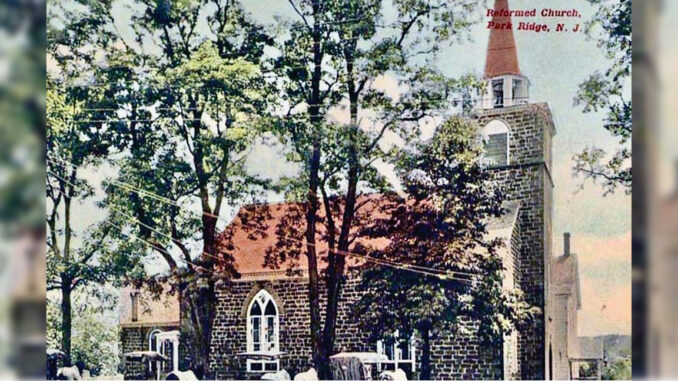
PARK RIDGE—More than 200 years’ worth of Christmases have been celebrated at the Pascack Reformed Church, the earliest church in the Pascack Valley.
It is hard to imagine what this region looked like when the church was built in 1813. The eight towns of today’s Pascack Valley, along with all the others extending eastward to the Hudson River, were part of one large township called Harrington. That vast expanse of land, which has now become 17 suburban towns with 110,000 residents, was sparsely populated with just 2,000 people back then.
Pascack was a vicinity within Harrington Township, centered around modern-day Park Ridge and Woodcliff Lake. The name was loosely based on a Lenape word, reflective of the indigenous people who were the first to set foot in the valley.
Where there are now suburban streets lined with houses, 200 years ago the land was divided into massive farms, some hundreds of acres wide. The families who owned them were by and large of Dutch descent, and their language and traditions reflected that. Their pragmatic sandstone houses dotted the landscape, but much of the township was still a barely tamed wilderness. The area was crisscrossed by a few narrow dirt roads, the predecessors of our paved thoroughfares. Pascack Road itself started as a path used by the Lenape.
Life was laborious and lacked our modern comforts, but Sundays meant a break from work in favor of going to church. The people followed the Dutch Reformed tradition, and those churches could be found in Paramus and Schraalenburgh (Bergenfield). At a time when overland travel was by horse-drawn wagon, having a place to worship in one’s own neighborhood was a huge benefit. The people of Pascack got their wish in 1813, after the Campbell and Wortendyke families deeded to the trustees, for a sum of $60, a 1-acre site on Pascack Road.
The Saddle River Reformed Church, recently broken off from Paramus, assisted the people of Pascack through a mutually beneficial arrangement. They would be one church with two locations, and a shared pastor would preach in each place on alternate Sundays.
The red sandstone used to build the Pascack church was readily available in the local area. It came from nearby outcroppings and was brought to the building site on wooden stone-boats pulled by oxen. As the walls took shape and grew in height, a way of hoisting the stone to the top was needed. According to a local legend, Mrs. Abraham Campbell, who lived across the road, loaned some of her home-spun linen sheets for that purpose.
The Rev. Stephen Goetschius was the first pastor, splitting him time between Pascack and Saddle River, and residing at the latter. The father of seven preferred to preach in Dutch over English, and was known for his robust constitution. Even as an octogenarian, Goetschius still rode on horseback between the Saddle River and Pascack churches. He served the dual congregations until age 84, in 1835, when his failing health forced him to retire.
The two churches stayed connected until 1854, at which time they became independent entities, each desiring to have weekly services and its own pastor.
The accompanying photographs show various views of the church from the turn of the 20th century. The pastor at the time was Rev. Edward Lodewick, who was installed in 1875. It was a prosperous era for the church, as Lodewick wrote in 1902:
“There are connected with the church a Ladies’ Aid Society, a Woman’s Missionary Society, and a Young People’s Society of Christian Endeavor, all of which are doing noble work in their various departments; also a flourishing Sabbath school. Legacies to the amount of $2,500 have been received by the church… The church is prepared to enter upon the new century united and harmonious, thanking God for the blessings of the past, and trusting Him for greater blessings in the future.”
The Rev. Edward Lodewick
Kristin Beuscher is president of Pascack Historical Society.
